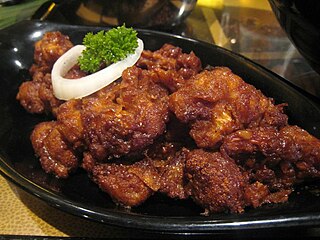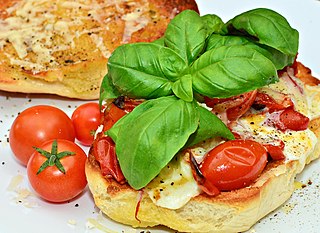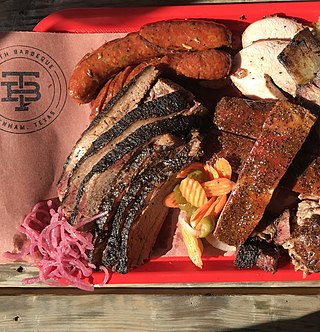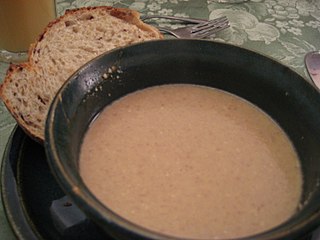
Fusion cuisine is a cuisine that combines elements of different culinary traditions that originate from different countries, regions, or cultures. They can occur naturally and become aspects of culturally relevant cuisines, or they can be part of the post-1970s movement for contemporary restaurant innovations.

A chocolate chip cookie is a drop cookie that features chocolate chips or chocolate morsels as its distinguishing ingredient. Chocolate chip cookies originated in the United States in 1938, when Ruth Graves Wakefield chopped up a Nestlé semi-sweet chocolate bar and added the chopped chocolate to a cookie recipe.

Louisiana Creole cuisine is a style of cooking originating in Louisiana, United States, which blends West African, French, Spanish, and Native American influences, as well as influences from the general cuisine of the Southern United States.

Coq au vin is a French dish of chicken braised with wine, lardons, mushrooms, and optionally garlic. A red Burgundy wine is typically used, though many regions of France make variants using local wines, such as coq au vin jaune (Jura), coq au riesling (Alsace), coq au pourpre or coq au violet, and coq au Champagne.

Giblets is a culinary term for the edible offal of a fowl, typically including the heart, gizzard, liver, and other organs.

Onion cake is a savory or sweet cake prepared using onion as a primary ingredient. Various onion cakes are consumed in Canada, China, Germany, Korea, Switzerland, Wales and other countries. Several types and varieties of onion cakes exist, including laobing, pajeon, the scallion pancake, Edmonton-style green onion cake, teisen nionod and zwiebelkuchen.
The history of Indian cuisine consists of cuisine of the Indian subcontinent, which is rich and diverse. The diverse climate in the region, ranging from deep tropical to alpine, has also helped considerably broaden the set of ingredients readily available to the many schools of cookery in India. In many cases, food has become a marker of religious and social identity, with varying taboos and preferences which has also driven these groups to innovate extensively with the food sources that are deemed acceptable.

The Western United States has its cuisine, distinct in various ways from that of the rest of the country. States west of Texas, Kansas, Missouri, and Nebraska would be considered part of this area, as would, in some cases, western parts of adjoining states.

Fuchsia Dunlop is an English writer and cook who specialises in Chinese cuisine, especially Sichuan cuisine. She is the author of five books, including the autobiographical Shark's Fin and Sichuan Pepper (2008). According to Julia Moskin in The New York Times, Dunlop "has done more to explain real Chinese cooking to non-Chinese cooks than anyone".

Food pairing is a method of identifying which foods go well together from a flavor standpoint, often based on individual tastes, popularity, availability of ingredients, and traditional cultural practices.
The fifth season of the American reality television series The Next Food Network Star premiered on Sunday, June 7, 2009. Food Network executives, Bob Tuschman and Susie Fogelson, were joined by Bobby Flay as the Selection Committee for this season, which was filmed early 2009 in New York, New York and Miami, Florida.

Barbecue chicken consists of chicken parts or entire chickens that are barbecued, grilled or smoked. There are many global and regional preparation techniques and cooking styles. Barbecue chicken is often seasoned or coated in a spice rub, barbecue sauce, or both. Marinades are also used to tenderize the meat and add flavor. Rotisserie chicken has gained prominence and popularity in U.S. grocery markets. Barbecued chicken is one of the world's most popular barbecue dishes.
AfroFoodtv.com is a website that is dedicated to African food and lifestyle. The site was launched in September 2006 by Yetunde “Yeti” Ezeanii in Atlanta, Georgia. Ezeanii serves as the chef and hostess of the website.

Cheese soup is a type of soup prepared using cheese as a primary ingredient, along with milk, broth and/or stock to form its basis. Various additional ingredients are used in its preparation, and various types and styles of cheese soup exist. It is a part of some cuisines in the world, such as American, Colombian, Mexican, Swiss, French, and Tibetan cuisines. Mass-produced cheese soups may be prepared with the addition of food additives to preserve them and enhance flavor. A list of cheese soups is included in this article.

Texan cuisine is the food associated with the Southern U.S. state of Texas, including its native Southwestern cuisine influenced Tex-Mex foods. Texas is a large state, and its cuisine has been influenced by a wide range of cultures, including Tejano/Mexican, Native American, Creole/Cajun, African-American, German, Czech, Southern and other European American groups.
Bipartite network projection is an extensively used method for compressing information about bipartite networks. Since the one-mode projection is always less informative than the original bipartite graph, an appropriate method for weighting network connections is often required. Optimal weighting methods reflect the nature of the specific network, conform to the designer's objectives and aim at minimizing information loss.

Corn stew is a stew prepared with corn (maize) as a primary ingredient. Many variations exist in ingredient usage and in methods of preparation. Corn stew is a dish in several cuisines of the world. Mazamorra is an historically old corn stew dish in South America that is prepared using simple ingredients, and is a dish in several other cuisines.

Avocado cake is a cake prepared using avocado as a primary ingredient, together with other typical cake ingredients. The avocados may be used as an ingredient in batter or as a topping.

Walnut soup is a broth-based or cream-based soup prepared using walnuts as a main ingredient. It is sometimes prepared in combinations using other ingredients, such as "pumpkin and walnut soup". Walnut soup is a part of the cuisines of China, Italy and Mexico.
Batchoy Tagalog, also known simply as batsoy, is a traditional Filipino food originating in the northern Philippines. It is a soup made with pork, pork offal, pork blood, noodles, chili leaves, green chilies, garlic, onions, and ginger. This dish is usually paired with or eaten with cooked rice as a meal.















